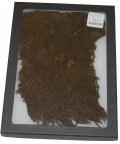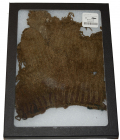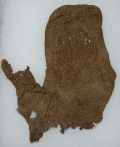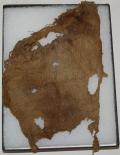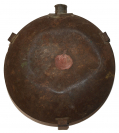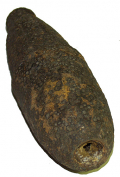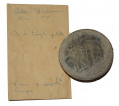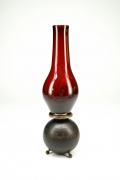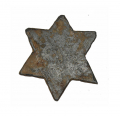site search
online catalog
Relics
Showing 101 to 120 out of 341
PIECE OF CIVIL WAR ARMY BLANKET FROM FORT PEMBINA, NORTH DAKOTA
The army had vast stocks of Civil War material left over at the end of the war. These supplies, along with the reduction of the postwar army meant U.S. troops were getting Civil War gear well into the… (1052-617). Learn More »
SCARCE INDIAN WAR SOLDIER’S MITTEN FROM FORT PEMBINA, ND
This comes from the excavations at Fort Pembina, occupied 1870-1895, where cold weather in winter months might well be a concern. The army began issuing mittens in 1873. Before that men were left to… (1052-620). Learn More »
INDIAN WAR SOLDIER’S MITTEN FROM FORT PEMBINA, ND
This comes from the excavations at Fort Pembina, occupied 1870-1895, where cold weather in winter months might well be a concern. The army began issuing mittens in 1873. Before that men were left to… (1052-619). Learn More »
SPRINGFIELD 1838 DATED M1816 PERCUSSION CONVERSION MUSKET FROM THE YORK SPRINGS, PA., G.A.R. POST, WITH MILITARY RACK MARKINGS
A good example of a classic early Civil War musket: a Model 1816 converted from flintlock to percussion in the early 1850s to bring it up to par with the new, percussion M1842 muskets. These are .69… (1202-429). Learn More »
CIVIL WAR-INDIAN WAR UNIFORM LAPEL FROM FORT PEMBINA
This strip of cloth showing three buttonholes (and what seems to be part of a fourth) is the remnant of an army dress coat discarded after its useful days were done at Fort Pembina, a small frontier… (1052-610). Learn More »
INDIAN WAR SOLDIER’S MITTEN PIECE FROM FORT PEMBINA, ND
This comes from the excavations at Fort Pembina, occupied 1870-1895, where cold weather in winter months might well be a concern. The army began issuing mittens in 1873. Before that men were left to… (1052-621). Learn More »
CIVIL WAR-INDIAN WAR FORAGE CAP VISOR
This is a well preserved leather visor from a forage cap recovered at Fort Pembina, ND, where it was preserved in remarkable condition by wet, anaerobic soil conditions. This is typical of the simple… (1052-485). Learn More »
CIVIL WAR-INDIAN WAR FORAGE CAP VISOR
This is a well preserved leather visor from a forage cap recovered at Fort Pembina, ND, where it was preserved in remarkable condition by wet, anaerobic soil conditions. This is typical of the simple… (1052-482). Learn More »
RELIC US CIVIL WAR CANTEEN: FROM YORK SPRINGS, PA, GAR POST #9
This regulation, smooth-sided canteen came from the York Springs G.A.R. post, is pretty clearly an early battlefield pick-up, and may well have a Gettysburg origin. It is untagged, however, with the… (2023-2674). Learn More »
U.S. 3” SCHENKL PERCUSSION SHELL – EAST CAVALRY FIELD, GETTYSBURG - GEISELMAN COLLECTION
This Federal, intact 3” Schenkl percussion shell specimen is a wonderful artillery relic recovered from East Cavalry Field sometime after the Battle of Gettysburg. The percussion shell measures 9”… (2024-2389). Learn More »
RELIC -- US NAVAL WATERCAP FUSE WITH BUSHING, DATED 1864
Excavated naval watercap fuse dated 1864 and in good condition. This fuse is made of brass with flange on top, with threaded portion and tapered body. A brass bushing is on this fuse to fit into… (2024-2327). Learn More »
EXCAVATED CONFEDERATE CAVALRY SABER
If they gave out awards for crudely made cavalry sabers, this one would be in the running. The guard is simple flat iron, curving in a broad semicircle, with a simple hole in one end through which the… (490-6746). Learn More »
ROUND EAGLE CARTRIDGE BOX SHOULDER BELT PLATE FROM 18th CORPS LINES, COLD HARBOR, EX-KERKSIS
This regulation belt plate for the cartridge box sling was in the collection of Syd Kerksis, well-known and respected early collector and author. It comes with his annotated envelope indicating he… (766-2044). Learn More »
$395.00
ON HOLD
WOODWARD GETTYSBURG LAMP USING A CONFEDERATE 12-POUND SIDE-LOADING SPHERICAL CASE SHOT
Local gunsmith Edward Woodward turned his talents to the relic business not long after the battle, selling relics picked up here to veterans and visitors as early as 1865, and is particularly known… (490-6965). Learn More »
$6,800.00
SOLD
SPEARHEAD FROM A BROKEN LANCE
This is the spearhead section only from a broken lance. The piece meas. approx. 38.50 inches long overall. The iron point of the spearhead itself is double edged with a raised ridge on each side… (490-3235). Learn More »
RELIC US PATTERN 1839 BELT PLATE
This Federal belt plate is of the regulation 1839 pattern. Constructed in the die-struck and rolled brass method, the brass accoutrement’s face shows a very clear “US”. Face has an even brown… (1256-102). Learn More »
RELIC, HAND-MADE UNION 8TH ARMY CORPS BADGE
Six-pointed star carved from a flat piece of white metal, likely pewter. In fine, “dug” condition with light oxidation on points and edges. Measures approximately 1.25” across points. Unknown… (490-6757). Learn More »
EXCAVATED CIVIL WAR US MODEL 1840 MUSICIAN’S SWORD
This pattern of sword for wear by musicians was part of the 1840 series of arms that included new patterns of cavalry saber, officer’s sword, non-commissioned officer’s sword, etc. This is similar… (490-6745). Learn More »
BUTTONS RECOVERED FROM BATTLE OF WÖRTH, 1870 – 45th, 48th & 56th FRENCH REGIMENTAL
The Battle of Wörth, also known as the Battle of Reichshoffen or as the Battle of Frœschwiller, refers to the second battle of Wörth, which took place on 6 August 1870 in the opening stages of… (1202-). Learn More »
RAIL SECTION FROM THE MANASSAS GAP BRANCH, ORANGE & ALEXANDRIA RAILROAD
This is a nicely labeled section of rail stamped in small letters: “Section of U. rail used on the Manassas Gap branch Orange & Alexandria R.R. during the war 1861-65” and signed on the top… (1202-186). Learn More »
Showing 101 to 120 out of 341
Most Popular
Historical Firearms Stolen From The National Civil War Museum In Harrisburg, Pa »
Theft From Gravesite Of Gen. John Reynolds »
Selection Of Unframed Prints By Don Troiani »
Fine Condition Brass Infantry Bugle Insignia »
Large English Bowie Knife With Sheath 1870’S – 1880’S »
Imported (Clauberg) Us Model 1860 Light Cavalry Officer's Saber »
featured item
FIRST ARMY CONTRACT SPENCER RIFLE: MICHIGAN CAVALRY BRIGADE AT GETTYSBURG
The story of Spencer rifle contracts, deliveries, and government payments for purchases is complicated. Laid out by Roy Marcot in his book on Spencer’s and in a 1997 article in “Man at Arms” by Wiley Sword, who has established the serial number… (490-7231). Learn More »



